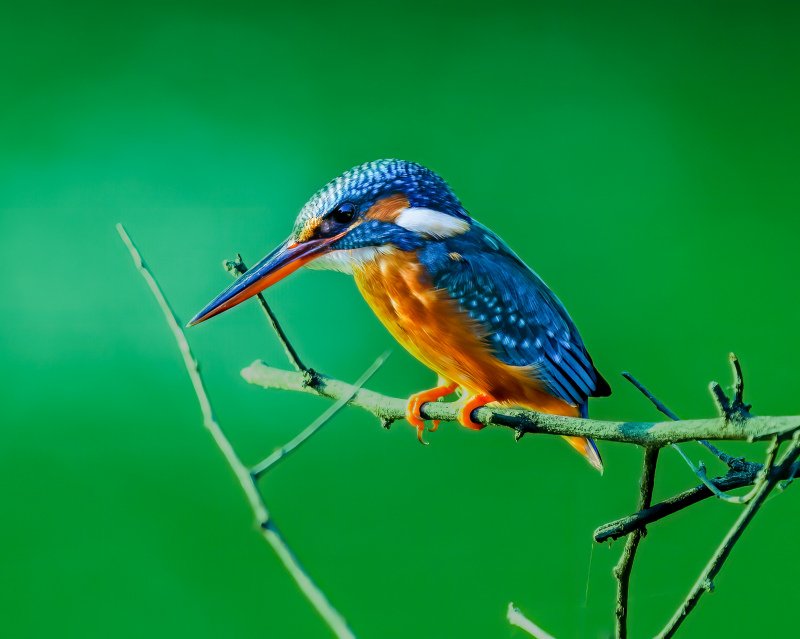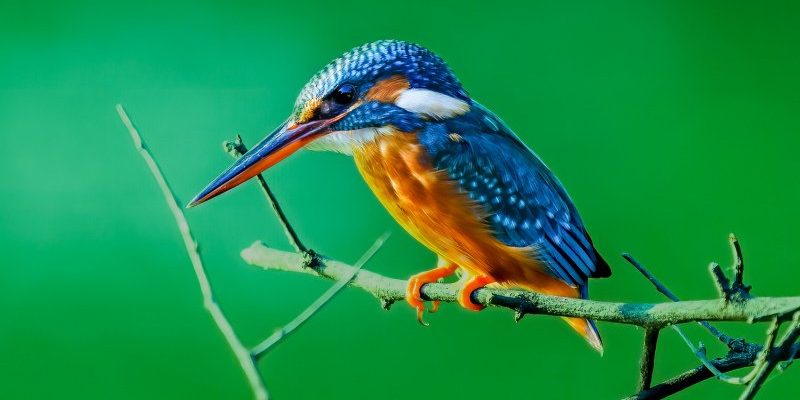
Imagine a little bird with feathers that shimmer in the sunlight, diving like a dart into a shimmering blue lake. That’s the Kingfisher for you! With around 90 different species scattered across various continents, these birds are known not just for their stunning colors but also for their incredible hunting skills. If you’ve ever watched a Kingfisher plunge into the water, you might have been surprised by how fast and accurate they are. Their sharp beaks and keen eyesight help them catch fish with impressive precision.
Kingfishers often inhabit watery environments like rivers, lakes, and wetlands, which makes them a delightful subject for birdwatchers and nature lovers alike. They’re like the jewels of the avian world, showcasing vibrant blues, oranges, and greens that can brighten up any dreary day. But there’s a lot more to these beauties than just their looks. Let’s take a closer look at what makes Kingfishers so unique—starting with some fascinating facts about them!
Interesting Facts About Kingfishers
| Size: | From 5 to 16 inches (12 to 40 cm) depending on the species |
| Habitat: | Near water bodies, rivers, lakes, and wetlands |
| Diet: | Mainly fish, but also insects and small amphibians |
| Speed: | Can dive at speeds of up to 40 mph (64 kph) |
| Lifespan: | Typically 4 to 6 years in the wild |
Physical Characteristics of Kingfishers
When you look at a Kingfisher, the first thing you notice is its astonishing plumage. These birds often display brilliant colors that can leave anyone in awe. The hues vary by species, but most commonly, you’ll see vibrant blues and fiery oranges. Their feathers aren’t just for show; they actually serve a purpose! The colors help them blend into their surroundings, making it easier for them to hunt or avoid predators. If you spot one perched on a branch, it might be tough to see at first, as they camouflage effortlessly with their environment.
Their body structure is specially adapted for their aquatic lifestyle. Kingfishers have long, narrow bills designed for spearing fish, which they can spot from afar thanks to their excellent eyesight. They also possess short legs, which might seem odd, but they’re actually perfect for perching and diving. When you see a Kingfisher dive, you might be surprised by how quickly they move. With just a quick flick of their wings, they plunge into the water with remarkable finesse. Their streamlined bodies allow for smooth movement through air and water alike.
Their eyes are particularly fascinating as well. Positioned on the sides of their heads, they provide a wide field of vision, allowing Kingfishers to detect movement in the water below. Plus, they can see polarized light, which is a real advantage when hunting for fish. It’s like having built-in sunglasses that enhance their ability to spot their prey. This unique combination of features makes them one of nature’s most efficient hunters!
Behavior and Hunting Techniques
Kingfishers are known for their agile, acrobatic flight. Their wings are built for rapid bursts of speed, enabling them to swoop down and capture fish with incredible precision. Once they spot a potential meal, they typically take off from their perch, hover briefly to gauge distance, and then dive headfirst into the water. You might think it sounds like something out of an action movie, but it’s all in a day’s work for a Kingfisher!
Once they’ve caught their prey, they’ll often return to a perch to enjoy their meal. They have a fascinating feeding technique where they beat their fish against the branch to stun it, making it easier to swallow. This isn’t just a show of strength; it’s an essential part of their feeding behavior. Kingfishers are also known for their territorial nature. Males particularly are quite vocal, often calling out to establish their claim over a hunting area. It’s their way of saying, “This is mine!”
When paired, Kingfishers can be seen engaging in elaborate courtship displays, including synchronized flying and feeding. These behaviors strengthen their bond and prepare them for the nesting season. Once the female is ready to lay eggs, she will dig a burrow in a riverbank, where she will lay her eggs and raise her young. The entire process—from hunting to nesting—demonstrates just how well-adapted these birds are to their environment.
Habitat and Distribution
Kingfishers are found on every continent except Antarctica, which is pretty impressive when you think about it. They thrive in diverse habitats, but they’re most commonly found near freshwater bodies. This includes rivers, lakes, ponds, and marshes. Some species even inhabit coastal areas, where they can hunt in tidal zones. Their presence is often a sign of a healthy ecosystem, as they feed on fish and other aquatic creatures.
The distribution of Kingfishers varies widely. In tropical regions, you’ll find the most colorful species, such as the Common Kingfisher and the Blue-eared Kingfisher. In contrast, some species, like the Belted Kingfisher, are well adapted to North America and can be found across a range of habitats from coastal areas to inland rivers. This adaptability makes them a fascinating group of birds to study as they can thrive in various environments.
When it comes to nesting, Kingfishers prefer to dig tunnels in the banks of rivers or lakes. They’ll use their sharp beaks to excavate a burrow, often choosing spots that offer a solid drop-off into the water. This not only protects their young from predators but also keeps the nest safe from flooding. Their choice of habitat plays a significant role in their survival, and it’s a big part of what makes these birds so intriguing.
Conservation Status
The conservation status of Kingfishers varies by species. While many are still common, some face threats from habitat loss, pollution, and climate change. Wetland draining and urban development have significantly reduced their natural habitats. As humans continue to alter landscapes, Kingfishers struggle to find suitable places to nest and hunt.
Efforts are ongoing to protect these beautiful birds and their habitats. Conservation programs often focus on wetland restoration, pollution reduction, and public awareness campaigns aimed at protecting their natural environments. Additionally, creating buffer zones around water bodies can help maintain the quality of their habitats. You might be surprised to learn that even small efforts at a local level can have a positive impact on bird populations.
Birdwatching communities play a vital role in conservation, too. By observing and documenting Kingfisher populations, enthusiasts can contribute valuable data that informs conservation strategies. So, if you enjoy spotting these colorful birds, remember that your interest can help raise awareness about the challenges they face—and that can lead to meaningful change.
Kingfisher Species Overview
Kingfishers are a diverse group of birds, with each species showcasing unique characteristics and adaptations. For instance, the Common Kingfisher, often found in Europe and Asia, is known for its striking blue and orange plumage. Meanwhile, the Belted Kingfisher of North America has a distinctive spotted belly and a more robust build, which aids it in catching larger fish.
Another fascinating species is the Kingfisher of the rainforest, such as the Black-capped Kingfisher. This bird sports a bold black cap and a bright yellow belly, making it stand out against the lush green backdrop of its habitat. Each species has adapted to its environment, developing specific hunting techniques and dietary preferences that suit their particular niches.
Understanding the different Kingfisher species helps us appreciate the incredible diversity within this bird family. Each one brings something unique to the table, whether it’s their color, size, or behavior. As you learn more about them, it’s exciting to think about the various ecosystems they inhabit and the roles they play within those environments.
FAQ
What do Kingfishers eat?
Kingfishers primarily feed on fish, which makes up a large part of their diet. However, they’re not picky eaters! They also munch on insects, small amphibians, and even some crustaceans. Their hunting skills are finely tuned for catching slippery fish, but they can adapt their diet based on what’s available in their environment.
How can I attract Kingfishers to my backyard?
If you want to attract Kingfishers, consider creating a small pond with clean water and some natural vegetation around it. You can also add perches nearby, like branches or stakes, where they can rest and scout for food. Keeping the area quiet and free from disturbance will increase your chances of seeing these beautiful birds.
Do Kingfishers migrate?
Some Kingfisher species do migrate, while others are more sedentary. For instance, the Belted Kingfisher is known to migrate south during winter, while the Common Kingfisher may remain in its breeding territory if the conditions are favorable. Migration patterns can vary based on food availability and climate changes.
What sounds do Kingfishers make?
Kingfishers have a variety of calls, which can range from sharp whistles to loud chattering sounds. These calls are used for communication, especially between mates or in territorial disputes. If you listen closely, you might hear their distinctive sounds while they hunt or interact with each other.
How can I identify different species of Kingfishers?
Identifying Kingfisher species involves looking at their coloration, size, habitat, and distinctive markings. For instance, the Common Kingfisher is small and brightly colored, while the Belted Kingfisher has a larger, chunkier body with a characteristic spotted belly. Field guides or birdwatching apps can help you learn more about each species and their unique features.
How long do Kingfishers live?
In the wild, Kingfishers typically have a lifespan of about 4 to 6 years. However, this can vary based on factors like species, environmental conditions, and predation. Some individuals may live longer in protected environments or under favorable conditions.
Are Kingfishers endangered?
While many Kingfisher species are not endangered, some face threats due to habitat destruction, pollution, and climate change. Conservation efforts are important to ensure these beautiful birds continue to thrive. By supporting local conservation initiatives, you can help protect their habitats and the delicate ecosystems they rely on.
Can Kingfishers swim?
Kingfishers are not built for swimming like ducks or other waterfowl. However, they are excellent divers! They can plunge into the water to catch fish but usually do not swim on the surface. Their streamlined bodies and powerful wings help them navigate effectively underwater for short bursts.
How do Kingfishers build their nests?
Kingfishers often dig burrows in sandy or soft riverbanks to create their nests. The female usually excavates the burrow, which can be quite deep. Inside, she lays her eggs and ensures a safe place for her young to hatch and grow. These nesting sites are typically hidden from predators, providing an added layer of protection.
Are Kingfishers social birds?
Kingfishers are generally solitary or found in pairs, particularly when nesting. They can be territorial, especially males during the breeding season. While they enjoy some social interactions, such as during courtship, they prefer to hunt and live independently most of the time.

